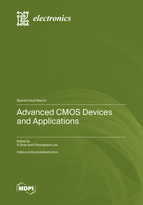Advanced CMOS Devices and Applications
A special issue of Electronics (ISSN 2079-9292). This special issue belongs to the section "Semiconductor Devices".
Deadline for manuscript submissions: closed (28 February 2023) | Viewed by 66201
Special Issue Editors
Interests: CMOS
Special Issues, Collections and Topics in MDPI journals
Interests: advanced logic CMOS technologies; novel transistor architectures; device physics
Special Issues, Collections and Topics in MDPI journals
Special Issue Information
Dear Colleagues,
We are pleased to invite you to submit your abstracts in the fields related to advanced CMOS transistors and emerging non-volatile memories, including materials fundamentals, process technologies, device physics, novel device architectures, and neuromorphic computing applications. The Special Issue aims to provide an overview of recent progress in advanced CMOS and memory technologies from research scientists and engineers working in the fields of semiconductor devices, materials, and reliability and to discuss the opportunities and challenges in these fields, as well as new findings, new phenomena, and state-of-the-art technologies related to advanced CMOS and memory devices. Papers related to device and material technologies for advanced CMOS and emerging non-volatile memories for neuromorphic computing applications are solicited, including the following:
(1) Advanced CMOS device architectures for high performance, ultralow-power consumption, and reliability improvement;
(2) Emerging materials and advanced process technologies for high-mobility channel, gate stack formation, S/D contact, and junction;
(3) Device physics, novel characterization methods, TCAD simulation, and ab initio calculation for advanced CMOS and emerging non-volatile memories;
(4) Conventional memories and emerging memories such as ReRAM, MRAM, PCRAM, and FeRAM;
(5) Memory device physics, reliability, and modeling;
(6) Synaptic devices for neuromorphic computing applications.
Prof. Dr. Yi Zhao
Prof. Dr. ChoongHyun Lee
Guest Editors
Manuscript Submission Information
Manuscripts should be submitted online at www.mdpi.com by registering and logging in to this website. Once you are registered, click here to go to the submission form. Manuscripts can be submitted until the deadline. All submissions that pass pre-check are peer-reviewed. Accepted papers will be published continuously in the journal (as soon as accepted) and will be listed together on the special issue website. Research articles, review articles as well as short communications are invited. For planned papers, a title and short abstract (about 100 words) can be sent to the Editorial Office for announcement on this website.
Submitted manuscripts should not have been published previously, nor be under consideration for publication elsewhere (except conference proceedings papers). All manuscripts are thoroughly refereed through a single-blind peer-review process. A guide for authors and other relevant information for submission of manuscripts is available on the Instructions for Authors page. Electronics is an international peer-reviewed open access semimonthly journal published by MDPI.
Please visit the Instructions for Authors page before submitting a manuscript. The Article Processing Charge (APC) for publication in this open access journal is 2400 CHF (Swiss Francs). Submitted papers should be well formatted and use good English. Authors may use MDPI's English editing service prior to publication or during author revisions.
Keywords
- advanced logic CMOS transistor
- emerging non-volatile memories
- neuromorphic computing
- high-mobility channel
- device physics
- novel characterization method
- simulation and modeling






